Related Research Articles

The first inhabitants of Tuvalu were Polynesians, so the origins of the people of Tuvalu can be traced to the spread of humans out of Southeast Asia, from Taiwan, via Melanesia and across the Pacific islands of Polynesia.
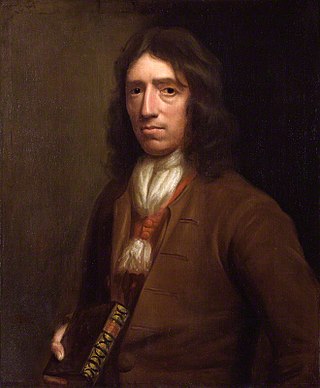
William Dampier was an English explorer, pirate, privateer, navigator, and naturalist who became the first Englishman to explore parts of what is today Australia, and the first person to circumnavigate the world three times. He has also been described as Australia's first natural historian, as well as one of the most important British explorers of the period between Sir Francis Drake and Captain James Cook ; he "bridged those two eras" with a mix of piratical derring-do of the former and scientific inquiry of the latter. His expeditions were among the first to identify and name a number of plants, animals, foods, and cooking techniques for a European audience, being among the first English writers to use words such as avocado, barbecue, and chopsticks. In describing the preparation of avocados, he was the first European to describe the making of guacamole, named the breadfruit plant, and made frequent documentation of the taste of numerous foods foreign to the European palate at the time, such as flamingo and manatee.
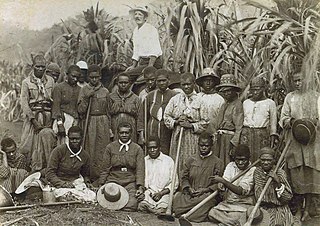
Kanakas were workers from various Pacific Islands employed in British colonies, such as British Columbia (Canada), Fiji, Solomon Islands, Vanuatu, Papua New Guinea, and Queensland (Australia) in the 19th and early 20th centuries. They also worked in California and Chile.

Kosrae, formerly known as Kusaie or Strong's Island, is an island in the Federated States of Micronesia. The State of Kosrae is one of the four states of the Federated States of Micronesia, and includes the main island of Kosrae and a few nearby islands and islets, the most significant of which is inhabited by 1,500 people.
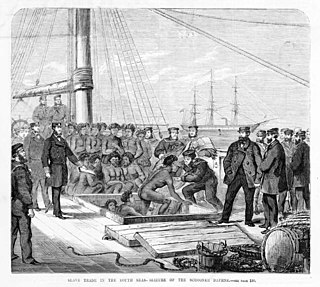
Blackbirding is the coercion of people through deception or kidnapping to work as slaves or poorly paid labourers in countries distant from their native land. The practice took place on a large scale with the taking of people indigenous to the numerous islands in the Pacific Ocean during the 19th and 20th centuries. These blackbirded people were called Kanakas or South Sea Islanders. They were taken from places such as Papua New Guinea, the Solomon Islands, Vanuatu, Niue, Easter Island, the Gilbert Islands, Tuvalu, Fiji, and the islands of the Bismarck Archipelago amongst others.
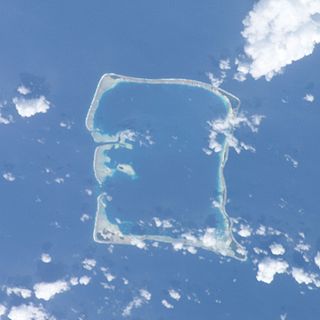
Nukufetau is an atoll that is part of the nation of Tuvalu. The atoll was claimed by the US under the Guano Islands Act some time in the 19th century and was ceded in a treaty of friendship concluded in 1979 and coming into force in 1983. It has a population of 597 who live on Savave islet. In 1951 the school that was located on Motumua islet was transferred to Savave and became the government primary school for Nukufetau. It was named the Tutasi Memorial School in honour of its predecessor.

Suwarrow is an island in the northern group of the Cook Islands in the south Pacific Ocean. It is about 1,300 kilometres (810 mi) south of the equator and 930 kilometres (580 mi) north-northwest of the capital island of Rarotonga.

William Henry "Bully" Hayes was a notorious American ship's captain who engaged in blackbirding in the 1860s and 1870s.

Savage Islands is a 1983 swashbuckling adventure film set in the South Pacific in the late 19th century. Directed by Ferdinand Fairfax and filmed on location in Fiji and New Zealand, it starred Tommy Lee Jones, Michael O'Keefe and Jenny Seagrove.
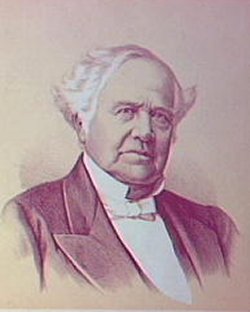
Robert Towns was a British master mariner who settled in Australia as a businessman, sandalwood merchant, colonist, shipowner, pastoralist, politician, whaler and civic leader. He was the founder of Townsville, Queensland and named it after himself, he is also known for his involvement in blackbirding and labour exploitation of immigrant workers.

McKean Island is a small, uninhabited island in the Phoenix Islands, Republic of Kiribati. Its area is 57 hectares.

Edward Davis or Davies was an English buccaneer active in the Caribbean during the 1680s and would lead successful raids against Leon and Panama in 1685, the latter considered one of the last major buccaneer raids against a Spanish stronghold. Much of his career was later recorded by writer William Dampier in A New Voyage Round the World (1697).

George Lewis Becke was at the turn of the nineteenth century, the most prolific, significant, and internationally renowned Australian-born writer of the South Pacific region. Having lived and worked among Pacific Islands and Islanders as a trader, ship's supercargo, and villager for some two decades, learning languages and observing natural and cultural life, Becke was prompted by J F Archibald of The Bulletin to write down his experiences, eventually becoming a popular and respected author of short stories, novellas, novels, as well as historic and ethnographic works.
Utwe is the second-largest municipality in the Micronesian state of Kosrae, the largest being Tafunsak.
Tembinok', or Tem Binoka, was the Uea of Abemama, Aranuka and Kuria, in the Gilbert Islands, during the late 19th century.

HMS Rosario was an 11-gun Rosario-class screw sloop of the Royal Navy, launched in 1860 at Deptford Dockyard. She served two commissions, including eight years on the Australia Station during which she fought to reduce illegal kidnappings of South Sea Islanders for the Queensland labour market. She was decommissioned in 1875, finally being sold for breaking nine years later. A team from Rosario played the first ever New Zealand International Rugby Union match against a Wellington side in 1870. She was the fifth Royal Navy ship to bear the name, which was first used for the galleon Del Rosario, captured from the Spanish in 1588.
HMS Renard was a schooner of the Royal Navy, built by John Cuthbert, Millers Point, New South Wales and launched 16 January 1873.

Rascals in Paradise is a 1957 collection of ten nonfiction short stories co-written by James A. Michener (1907-1997) and University of Hawaii professor Arthur Grove Day (1904-1994). The collection comprises ten historical adventure stories about historical people and events in the Pacific islands.
Alfred Restieaux (1832–1911) was born in Paris, France, and came from a family of French descent. His grandfather was a French nobleman who escaped the guillotine during the French Revolution. At the age of 16 he migrated to Australia and later he travelled to South America and North America. He later became an island trader in the central Pacific. From 1867 to 1872 he had dealings with Ben Pease and Bully Hayes, two of the more notorious captains of ships and blackbirders that operated in the Pacific at that time.
A Modern Buccaneer (1894) is a novel by Australian writer Rolf Boldrewood.
References
- ↑ "The Pease Family of Martha's Vineyard by Richard Bart".
- ↑ "The Pease Family of Martha's Vineyard: Eighth Generation by Richard Bart".
- ↑ Martha’s Vineyard Museum, Captain Henry Pease Papers, 1867-1893. Record Unit 331 "Archived copy" (PDF). Archived from the original (PDF) on 2010-07-03. Retrieved 2011-05-18.
{{cite web}}: CS1 maint: archived copy as title (link) - 1 2 3 4 5 6 7 James A. Mitchener & A. Grove Day (1957). "Bully Hayes, South Sea Buccaneer". Rascals in Paradise. Secker & Warburg.
- ↑ Julian Dana, Gods Who Die (1935)
- ↑ Resture, Jane. "Alfred Restieaux: Stories of Bully Hayes and Others" . Retrieved 2011-08-06.
- ↑ Resture, Jane. "The Story of Blackbirding in the South Seas - Part 1" . Retrieved 2011-08-06.
- ↑ Resture, Jane. "The Story of Blackbirding in the South Seas - Part 2" . Retrieved 2011-08-06.
- 1 2 3 4 Restieaux, Alfred. Recollections of a South Seas Trader – Reminiscences of Alfred Restieaux. National Library of New Zealand, MS 7022-2.
- 1 2 3 4 Restieaux, Alfred. Reminiscences - Alfred Restieaux Part 2 (Pacific Islands). National Library of New Zealand, MS-Papers-0061-079A.
- ↑ "Kosrae Nautilus Resort". Archived from the original on 2011-07-13. Retrieved 2011-06-18.
